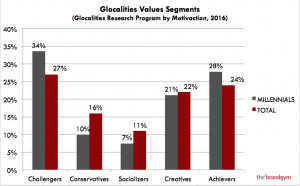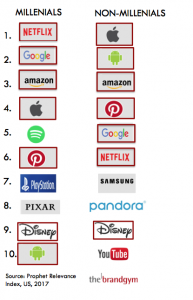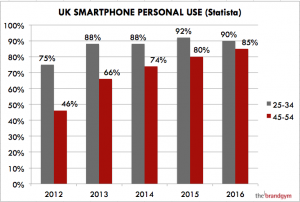‘Millennials’ is one of the most over-used and mis-used buzzwords in marketing today. The term is often used to mistakenly portray people aged c. 25-34 as a homogeneous segment in their own right.
Below I look at the risks of treating Millennials as a segment, and examples of brands who have avoided this trap.
1. Not all Millennials are the same
The idea that Millennials are a segment with shared needs, attitudes and beliefs is simply bollocks.
“Larger differences in values and lifestyles exist within the Millennial generation than between generations,” according to Martin Schiere of Motivaction, who carried out the Glocalities Research Program, a global survey of attitudes and values. Some Millennials are more conservative, and others more creative or achievement-focused, as the graph below shows.

There are slight differences between Millennials and the total sample, with slightly more ‘Challengers’ and less ‘Conservatives’. But the concept of the younger generation challenging convention is nothing surprising or new.
This is why it makes little sense to create entirely new brand targeted at Millennials, as Air France are doing with their Joon airline that I posted on here.

2. Millennials brand choices are not that different
A popular myth of modern marketing is that Millennials are pissed off with big brands and are leaving them in droves.
Well, what happens when you look at the US Millennials’s Top 10 most relevant brands compared to non-Millennials?
Seven of the top 10 are the same.
This should is not a surprise, when that Millennials’ values are not that different from the rest of us, as the data earlier showed. And it shows that big brands can appeal to the younger generation if they maintain relevance by revitalising their products, service and marketing.

3. Looking at demographics, not needs
Looking at Millennials as a segment is superficial in the extreme.
Ironically, the terminology is new age, but the thinking is Stone Age, focusing on demographics instead of digging deeper to look at attitudes, needs and values.
Yes, younger people are, on the whole, more willing to try new things, as they always have been.
But smart brands identify and tap into the deeper needs that are prevalent amongst this life-stage, but shared across generations.
Apple’s beautiful design, innovation and ease of use make it the most loved smartphone for everyone from Millennials to Boomers.
4. ‘Usage gaps’ close over time
A further point on brand and product adoption is how gaps in usage between younger and older generations tend to close over time.
This is why targeting Millennials as a segment means missing out on the potential of older generations who will increasingly take on the same habits.
The 25-34 age groups were quick to adopt smartphones that old farts like me, with a 29% to gap in penetration in 2012.
However, fast forward five years and this gap has closed to only 5% pts.

In conclusion, targeting Millennials as a segment is short-sighted, shallow and lazy. Dig deeper to understand the values, attitudes and needs which may be prevalent in this life-stage, but also have cross-generational relevance.
And remember, us oldies catch up in the end!
